Nano-Impact (Fatigue) Characterization of As-Deposited Amorphous Nitinol Thin Film
Abstract
:Nomenclature
1. Introduction
2. Experimental Section
2.1. Test Specimen
2.2. Nanoindentation Testing and Measurements
2.3. Nano-Impact Testing and Measurements
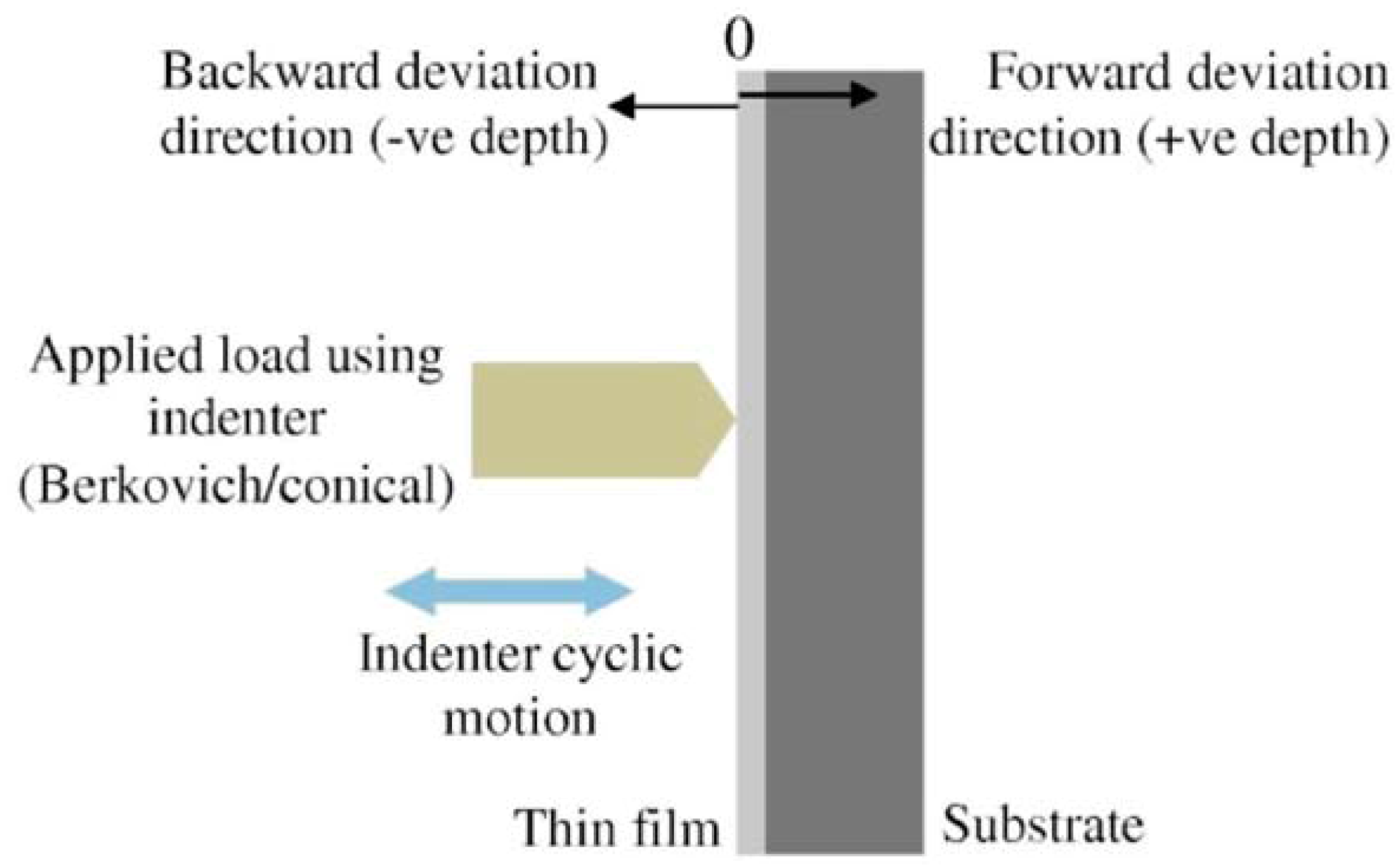
| Sl. No. | Impact load, P (mN) | No. of impacts | Total test time (s) | Indenter shape (number of repeats) | |
|---|---|---|---|---|---|
| Berkovich | Conical | ||||
| 1 | 0.5 | 1000 | 2000 | 5 | 5 |
| 2 | 1 | 1000 | 2000 | 5 | 5 |
| 3 | 10 | 1000 | 2000 | 5 | 5 |
| 4 | 100 | 1000 | 2000 | 5 | 5 |
3. Results
3.1. Film Characterization
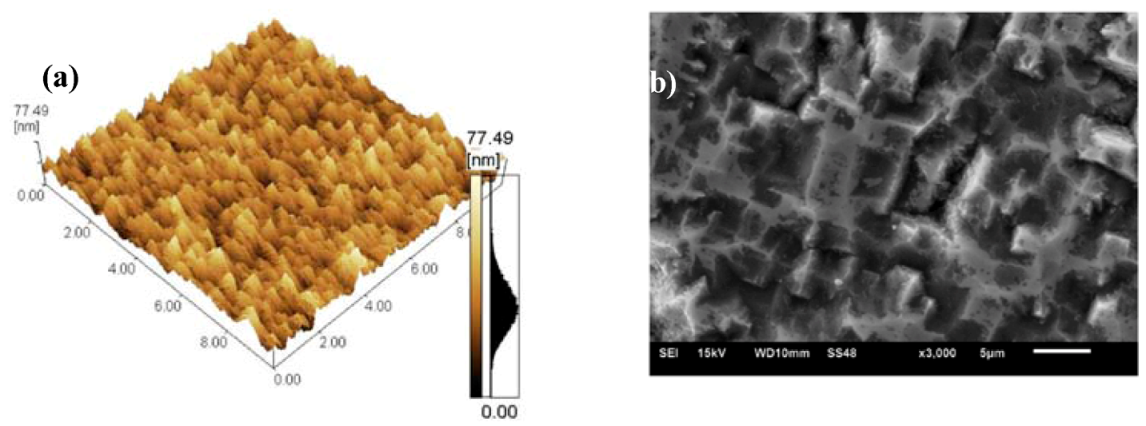
3.2. Nano-Impact Testing of TiNi Thin Film
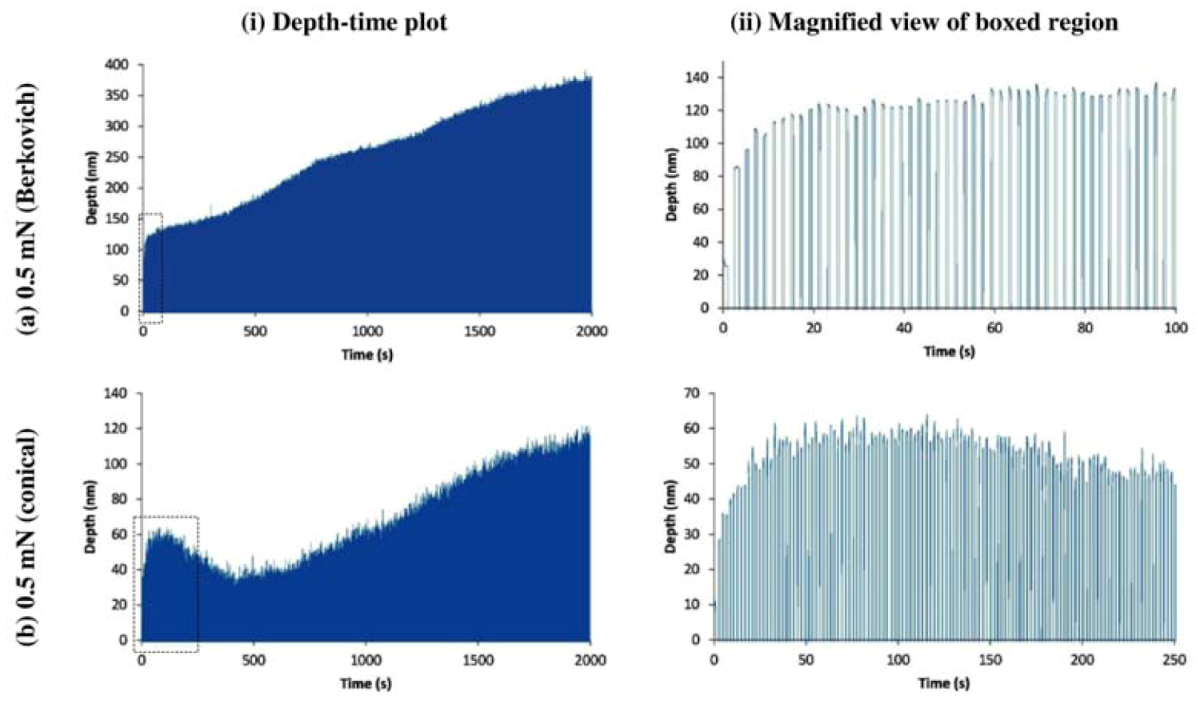
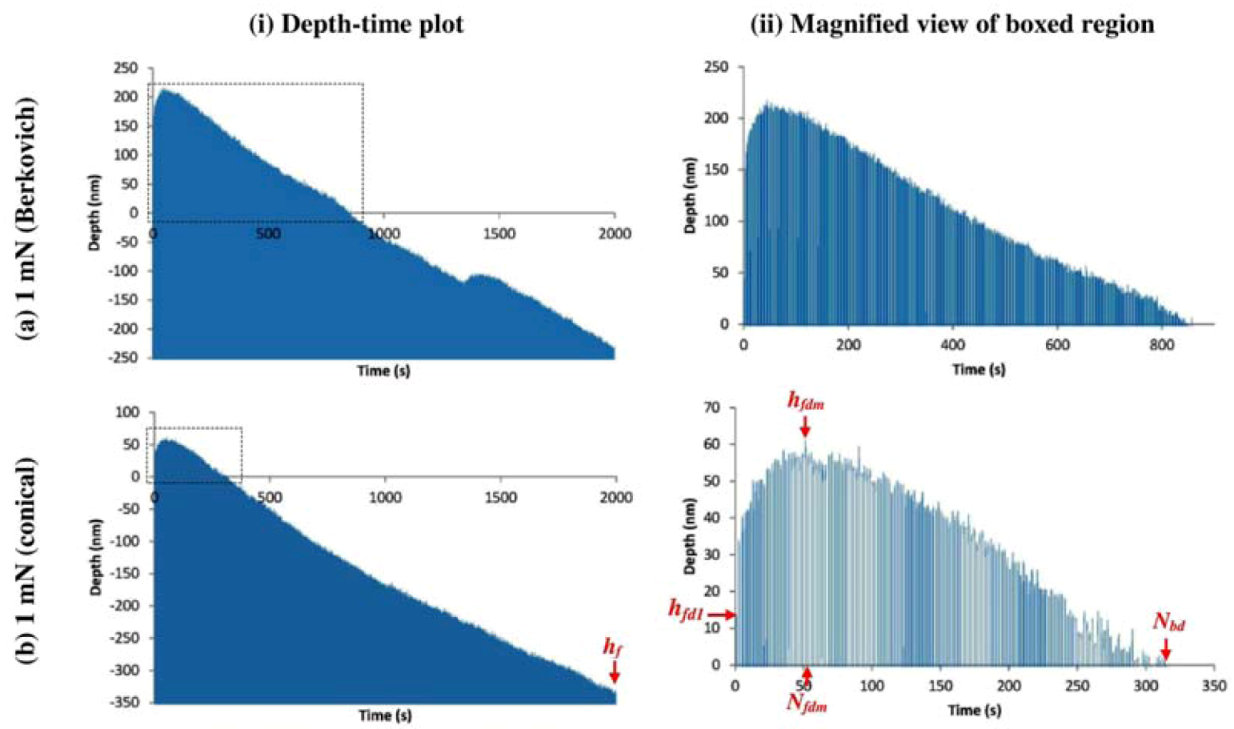

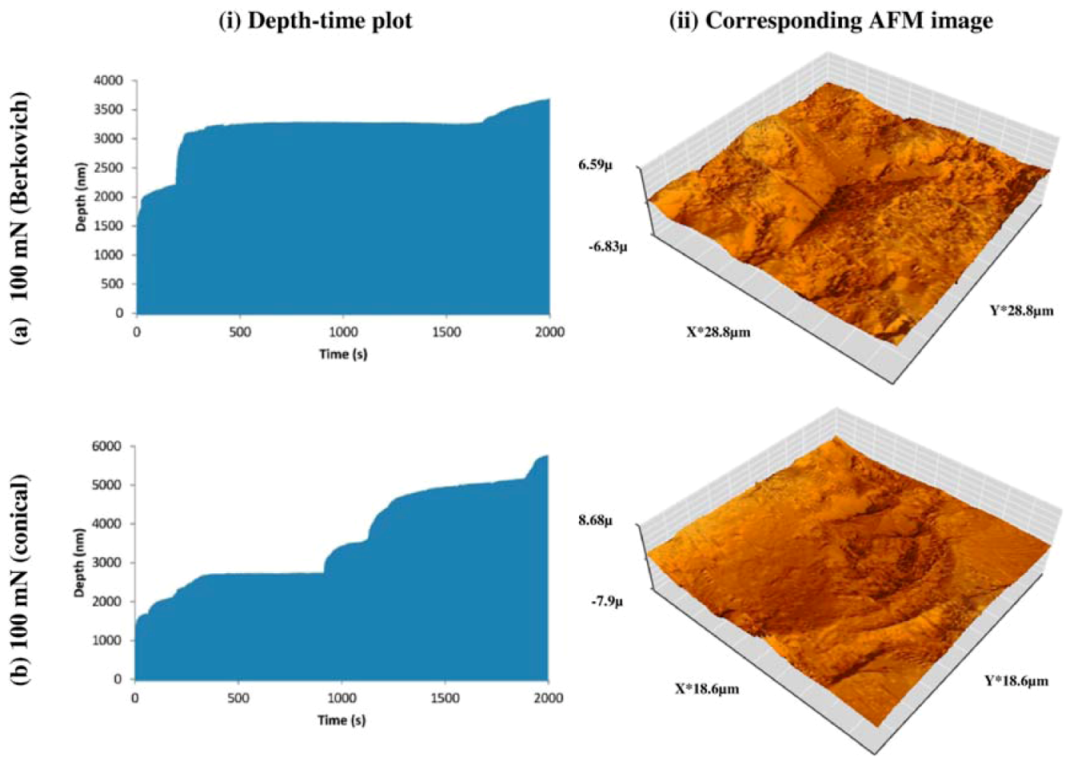
| Impact load, P (mN) | Berkovich | Conical | ||
|---|---|---|---|---|
| FD out of 5 | BD out of 5 | FD out of 5 | BD out of 5 | |
| 0.5 | 5 | 0 | 5 | 0 |
| 1 | 0 | 5; *(3−, 2+) | 0 | 5; *(3−, 2+) |
| 10 | 0 | 5; *(2−, 3+) | 0 | 5; *(1−, 4+) |
| 100 | 1 | 4; *(0−, 4+) | 5 | 0 |
3.3. Features in Nano-Impact Depth vs. Time Curve



4. Discussion
4.1. Impact Residual Impression
4.2. Depth vs. Time Curve and Film-Substrate Failure Behavior
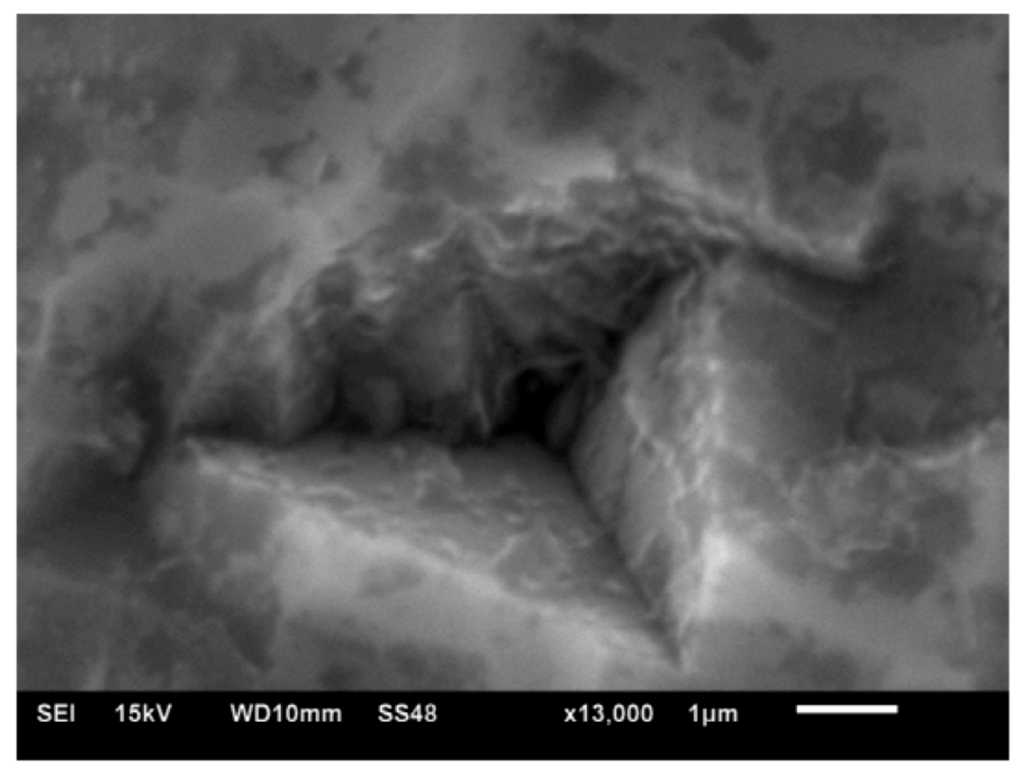
4.3. Fatigue Performance of TiNi Thin Film and Future Prospects
5. Conclusions
- (a) Based on the indenter contact depth deviation data, two types of film failure mechanisms are proposed. The failure of films starts from delamination at the film-substrate interface, resulting in a decrease in contact depth (backward depth deviation), whereas, a typical increase in contact depth (forward depth deviation) with number of fatigue cycles was also recorded.
- (b) Two types of backward depth deviation were observed for Berkovich and conical indenter. Type I indicates that the final impact depth is below zero, corresponding to a large film delamination gap; whereas, Type II indicates that the final impact depth is above zero, indicating a low film delamination gap.
- (c) The delamination failure indicated release of elastic stored energy (residual stress), and can be indicated through peculiar decrease in contact depth for Berkovich and conical indenters.
- (d) Indenter shape and nano-impact load had little influence on the type (forward or backward) of depth deviations.
References
- Fu, Y.Q.; Du, H.; Huang, W.; Zhang, S.; Hu, M. TiNi-based thin films in MEMS applications: A review. Sens. Actuat A 2004, 112, 395–408. [Google Scholar] [CrossRef]
- Pelton, A.R. Nitinol fatigue: A review of microstructures and mechanisms. J. Mater. Eng. Perform. 2011, 20, 613–617. [Google Scholar] [CrossRef]
- Pelton, A.R.; Schroeder, V.; Mitchell, M.R.; Gong, X.-Y.; Barney, M.; Robertson, S.W. Fatigue and durability of Nitinol stents. J. Mech. Behav. Biomed. Mater. 2008, 1, 153–164. [Google Scholar] [CrossRef]
- Miyazaki, S.; Ishida, A. Martensitic transformation and shape memory behavior in sputter-deposited TiNi-base thin films. Mat. Sci. Eng. A 1999, 273–275, 106–133. [Google Scholar] [CrossRef]
- Krulevitch, P.; Lee, A.P.; Ramsey, P.B.; Trevino, J.C.; Hamilton, J.; Northrup, M.A.M.A. Thin film shape memory alloy microactuators. J. Microelectromech. Syst. 1996, 5, 270–282. [Google Scholar]
- Fu, Y.Q.; Du, H.J.; Zhang, S. Curvature Method as a Tool for Shape Memory Effect. In Surface Engineering: Science and Technology II, Symposium at TMS 2002 Annual Meeting, TMS, Seattle, WA, USA, 17–21 February 2002; Kumar, A., Chung, Y.W., Moore, J.J., Doll, G.L., Yahi, K., Misra, D.S., Eds.; pp. 293–303.
- Faisal, N.H.; Ahmed, R.; Fu, Y.Q. Nano-Impact Testing and Failure Mechanism of Solar Panel DLC Film. In Proceedings of the Advanced Materials Technologies Conference (AMTC’11), Riyadh, Saudi Arabia, 17–19 October 2011; King Abdulaziz City for Science and Technology: Riyadh, Saudi Arabia, 2011; pp. 36–44. [Google Scholar]
- Beake, B.D.; Garcia, M.J.I.; Smith, J.F. Micro-impact testing: A new technique for investigating fracture toughness. Thin Solid Films 2002, 398–399, 438–443. [Google Scholar]
- Beake, B.D.; Lau, S.P.; Smith, J.F. Evaluating the fracture properties and fatigue wear of tetrahedral amorphous carbon films on silicon by nano-impact testing. Surf. Coat. Technol. 2004, 177–178, 611–615. [Google Scholar]
- Faisal, N.H.; Ahmed, R.; Reuben, R.L. Indentation testing and its acoustic emission response: Applications and emerging trends. Int. Mater. Rev. 2011, 56, 98–142. [Google Scholar]
- Li, X.D.; Bhushan, B. Development of a nanoscale fatigue measurement technique and its application to ultrathin amorphous carbon coatings. Scr. Mater. 2002, 47, 473–479. [Google Scholar] [CrossRef]
- Bhushan, B.; Li, X. Nanomechanical characterization of solid surfaces and thin films. Int. Mater. Rev. 2003, 48, 125–164. [Google Scholar] [CrossRef]
- Bhushan, B. Nanotribology and nanomechanics. Wear 2005, 259, 1507–1531. [Google Scholar] [CrossRef]
- Faisal, N.H.; Ahmed, R.; Fu, Y.Q.; Elakwah, Y.O.; Alhoshan, M. Influence of indenter shape on DLC film failure during multiple load cycle nanoindentation. Mater. Sci. Technol. 2012. Available online: http://dx.doi.org/10.1179/1743284712Y.0000000039.
- Ahmed, R.; Fu, Y.Q.; Faisal, N.H. Fatigue at nanoscale: An integrated stiffness and depth sensing approach to investigate the mechanisms of failure in diamond-like carbon film. J. Tribol. 2012, 134, 012001. [Google Scholar]
- Fu, Y.Q.; Du, H.J.; Zhang, S.; Ong, S.E. Effects of silicon nitride interlayer on phase transformation and adhesion of TiNi films. Thin Solid Films 2005, 476, 352–357. [Google Scholar] [CrossRef]
- Fu, Y.Q.; Du, H.J.; Zhang, S. Functionally graded TiN/TiNi shape memory alloy films. Mater. Lett. 2003, 57, 2995–2999. [Google Scholar] [CrossRef]
- Fu, Y.Q.; Du, H.J.; Zhang, S. Deposition of TiN layer on TiNi thin films to improve surface properties. Surf. Coat. Technol. 2003, 167, 129–136. [Google Scholar] [CrossRef]
- Fu, Y.Q.; Zhang, S.; Wu, M.J.; Huang, W.M.; Du, H.J.; Luo, J.K.; Flewitt, A.J.; Milne, W.I. On the lower thickness boundary of sputtered TiNi films for shape memory application. Thin Solid Films 2006, 515, 80–86. [Google Scholar] [CrossRef]
- Huang, W.; Pellegrino, S.; Bashford, D.P. Materials and Mechanical Testing. In Proceedings of the Conference on Spacecraft Structures, Noordwijk, The Netherlands, 27–29 March 1996.
- Faisal, N.H.; Ahmed, R. A review of patented methodologies in instrumented indentation residual stress measurements. Recent Pat. on Mech. Eng. 2011, 4, 138–152. [Google Scholar] [CrossRef]
- Faisal, N.H.; Steel, J.A.; Ahmed, R.; Reuben, R.L. The use of acoustic emission to characterize fracture behavior during Vickers indentation of HVOF thermally sprayed WC-Co coatings. J. Therm. Spray Technol. 2009, 18, 525–535. [Google Scholar] [CrossRef]
- Faisal, N.H.; Reuben, R.L.; Ahmed, R. An improved measurement of Vickers indentation behaviour through enhanced instrumentation. Meas. Sci. Technol. 2011, 22. [Google Scholar]
- Li, X.D.; Bhushan, B. Micro/nanomechanical and tribological studies of bulk and thin-film materials used in magnetic recording heads. Thin Solid Films 2001, 398, 313–319. [Google Scholar] [CrossRef]
- Bull, S.J. Nanoindentation of coatings. J. Phys. D Appl. Phys. 2005, 38, R393–R413. [Google Scholar] [CrossRef]
- Lawn, B.R.; Cook, R.F. Probing material properties with sharp indenters: A retrospective. J. Mater. Sci. 2012, 47, 1–22. [Google Scholar] [CrossRef]
- Drory, M.D.; Hutchinson, J.W. Measurement of the adhesion of a brittle film on a ductile substrate by indentation. Proc. R. Soc. London Ser. A 1996, 452, 2319–2341. [Google Scholar]
- Cordill, M.J.; Bahr, D.F.; Moody, N.R.; Gerberich, W.W. Recent development in thin film adhesion measurement. IEEE Trans. Device Mater. Reliab. 2004, 4, 163–168. [Google Scholar] [CrossRef]
- Raju, T.D.; Nakasa, K.; Kato, M. Relation between delamination of thin films and backward deviation of load-displacement curves under repeating nanoindentation. Acta Mater. 2003, 51, 457–467. [Google Scholar] [CrossRef]
- Ma, X.-G.; Komvopolous, K. Nanoscale pseudoelastic behavior of indented titanium-nickel films. Appl. Phys. Lett. 2003, 83, 3773–3775. [Google Scholar] [CrossRef]
- Kumar, A.; Kaur, D. Nanoindentation and corrosion studies of TiN/NiTi thin films for biomedical applications. Surf. Coat. Technol. 2009, 204, 1132–1136. [Google Scholar] [CrossRef]
© 2012 by the authors; licensee MDPI, Basel, Switzerland. This article is an open-access article distributed under the terms and conditions of the Creative Commons Attribution license (http://creativecommons.org/licenses/by/3.0/).
Share and Cite
Faisal, N.H.; Ahmed, R.; Fu, R. Nano-Impact (Fatigue) Characterization of As-Deposited Amorphous Nitinol Thin Film. Coatings 2012, 2, 195-209. https://doi.org/10.3390/coatings2030195
Faisal NH, Ahmed R, Fu R. Nano-Impact (Fatigue) Characterization of As-Deposited Amorphous Nitinol Thin Film. Coatings. 2012; 2(3):195-209. https://doi.org/10.3390/coatings2030195
Chicago/Turabian StyleFaisal, Nadimul H., Rehan Ahmed, and Richard Fu. 2012. "Nano-Impact (Fatigue) Characterization of As-Deposited Amorphous Nitinol Thin Film" Coatings 2, no. 3: 195-209. https://doi.org/10.3390/coatings2030195




